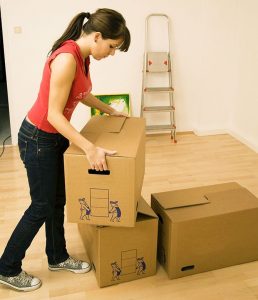Normally, it’s wise to keep the drawers within your dresser while it’s being moved because they make the dresser stronger.
Even though the dresser is slightly heavier for the movers to carry with the drawers in it, they only have to make one trip with it rather than making a trip with it and then numerous more trips with each of its drawers. Snugly padding a dresser and securing the pads with tape will hold the drawers in place so that they don’t fall out during moving.
How to Prepare a Dresser or a Chest of Drawers for Moving
Before moving a chest of drawers it’s always best to empty its drawers entirely.
At least, empty them entirely of small loose or breakable objects like trinkets, because they will fly out when you’re moving a chest of drawers as it is tipped to go up / down stairs, through doorways or on/off th truck. If you want to leave some lighter clothing items in the
Take notice that any extra weight in the dresser’s drawers can put adverse pressure on the drawer’s glides which can damage them, even under normal moving pressures.
Mirrors (if any) should be removed before padding a dresser.
Mirrors should be separately wrapped in pads and boxed for transport. But if there’s any glass/mirrors set into the finish of the dresser, then flattened cardboard should be taped over the part of the pad that’s covering the inlays. This will protect the glass and the marble and will signal each of your movers handling the dresser as to where the glass is under the
Can You Use the Drawers as Moving Boxes
It may seem better to you to just leave all of the contents in the drawers, pull them out, and use them like boxes to carry those things. In some situations, it may actually be easier to do this rather than to pack the things from the drawers into boxes and then unpack them later and put them back into the drawers. In such a case, go ahead and take these drawers full of stuff out of the dresser and make your multiple trips. It’s a
However, if you do put the full drawers back into the dresser when it gets onto the truck, bear in mind that you could damage the drawer’s glides, since the weight of the drawer will be bounced on its glides within the dresser by the movement of the truck.
And remember – if you take the drawers and their contents out of the dresser, then you have to put them somewhere on the truck in such a way that the contents don’t get shaken out of the drawers while the truck is moving. You could put the drawers into a van or a car to solve this problem because it travels smoother than a truck. You could also plastic wrap the drawers for transport on the truck to hold all of their contents inside.
Also, keep in mind that when carrying the drawers separately, it is easy to scratch or gouge their finish, so be very careful.
In conclusion, it is almost always best to just empty the drawers and then move them inside of the blanket wrapped dresser.
How to Pad a Dresser
To be able to safely move your dresser with its drawers in it, you need to know how to pad the furniture to hold its drawers in place and protect its finish while it’s being moved.
You start by putting one or two large moving blankets over the top of the dresser and draping them down over the sides, front, and back, past the bottom.
Then, diaper the dresser by using movers packing tape tightly wrapped around the pads to hold them firmly in place during the move. Do not let the tape stick to the finish of the dresser, since this could damage it by leaving hard to remove tape residue.
Tape the blankets snugly to the front, sides, and back of the dresser by winding the tape 4 or more times around it, circling the piece repeatedly from top to bottom. Then, tip the dresser up and tape the padding under its bottom. In this manner, the blankets will stay firmly over, around, and under the dresser, fully protecting it.
The purpose of padding under the dresser is to let you easily slide it on the truck or on hardwood floors without damaging them.
High Dressers
If the dresser is a high-boy, then first set a pad down on the floor and set the dresser centered upon it. Next, lift the pad and tape it snugly around the sides, front, and back of the furniture to hold it up. Only allow the tape to touch the pad, not the dresser’s finish so as to avoid tape residue damage. Then do the padding as described above from the top down and tape the top pad(s) securely to the bottom pad so neither will come loose during the move.
These securely snugged pads – top and bottom – will thoroughly protect the dresser and will hold all of its drawers in place so that they won’t fall out while it’s being moved.
Long Dressers
For long 9


